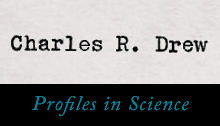Education
Higher Education Modules
Life after Death: Dr. Charles Drew, Civil Rights, and the Legacy of Race
Class 4: "Bad Blood" and the Superstition of Science
Introduction
Class four focuses on the American Red Cross policy of segregating blood based on race during the Second World War. Much to the frustration of Dr. Charles Drew, the Red Cross still held onto long-standing beliefs that African Americans had "bad blood" and the intermingling of blood between races was scientifically untenable and socially unacceptable. The result was a policy rooted in superstitious ideas of scientific racism that continues to shape discourses of race, medicine and society.
Readings
Love, Spencie. One Blood: The Death and Resurrection of Charles R. Drew. Chapel Hill: University of North Carolina Press, 1996, chapters 5-7.
Hunter, Tera. To Joy My Freedom: Southern Black Women's Lives and Labors After the Civil War. Cambridge: Harvard University Press, 1997, chapter 9.
Tapley, Mel. "An American Tragedy." Cartoon. Reprinted in Keith Wailoo's Dying in the City of the Blues. Available online.
Wailoo, Keith. Dying in the City of the Blues: Sickle Cell Anemia and the Politics of Race and Health. Chapel Hill: University of North Carolina Press, 2001, pp. 89-90.
Films:
RACE—The Power of an Illusion, Episode 3: The House We Live In. DVD and Educational Streaming. Directed by Llewellyn M. Smith. San Francisco: California Newsreel, 2003. Transcript available on line at http://newsreel.org/transcripts/race3.htm.
Discussion Questions
- What was the rationale behind the separation of "Negro" and "Non-Negro" blood for transfusions? Was there any scientific proof for the idea that hidden dangers lay nascent in the blood of African Americans and special virtues in those of other so-called racial groups?
- What do you think "An American Tragedy" is saying about blood segregation policies? Do you find parts of the cartoon ironic or particularly telling about science and race? How do political or satirical cartoons play a role in how we think about historical and contemporary issues? Name a few of your favorite cultural commentators, newspapers, or magazines that speak to important social issues.
- Put yourself for a moment in the shoes of Dr. Charles Drew. After spending so much energy standardizing the process of blood transfusions to save lives how do you think Dr. Drew, as an African American, felt when this segregation policy was put into place? Are there remnants of this policy in how we think about healthcare and medicine now?
- If you were an African American soldier during the Second World War how would you respond to making sacrifices and putting your life in jeopardy for the United States overseas, but continuing to experience racial violence and segregation upon returning to American soil?


